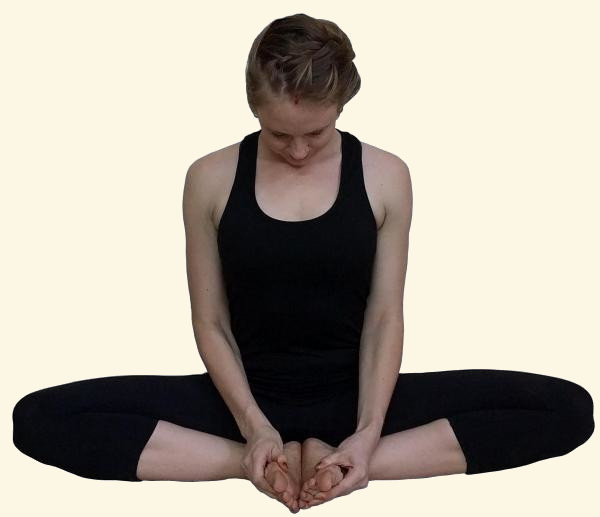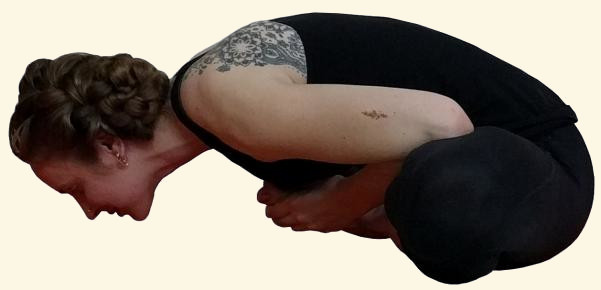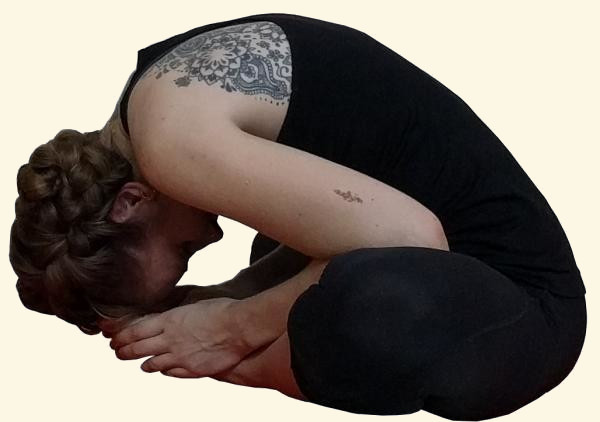Baddha Konasana – Baddha- bound/bind, Kon- angle,
The bound angle pose is sometimes called Cobbler’s Pose because of how cobblers sit in India holding the footwear between their feet while mending them. This posture opens the hips and works on the flexibility of the groin and inner thighs. It is one of the best postures to open the Sacral (swadisthana) chakra where the body tends to hold lots of unresolved emotional issues, and so for some this pose can be more emotionally intense than physically. As a result, many people find it difficult to move in this direction, but spending a long time there can be helpful.
Baddha Konasana A

- Starting in Dandasana join the soles of the feet together and bring the heels as close to the groin as possible while maintaining a straight back. There is a tendency of rounding the back so keep awareness to avoid this, it may help to practice with your back against a wall.
- Hold the feet with your hands, and bring your shoulder blades down to open the chest. Using the muscles around the hips to send the knees towards the floor while also opening the soles of the feet as if you are opening a book.
- With an inhale lengthen and straighten your spine. It may help to imagine you are pushing something up with the top of your head, then with an exhale bring the chin towards the chest (Jalandhar bandha). Gaze towards the tip of the nose.
- Try to stay in the posture for a minimum of 10 breaths (this might vary depending on the type of practice you are doing)
From here you can go into variation B
Baddha konasana B

- From the last position in A bring the chin back up to a neutral position, inhale lengthen your spine again
- Exhale send the belly button forward, and the chest and chin towards the ground.
- Try to maintain a straight spine, you can use the elbows on the inner thighs to send the knees further towards the ground but there should be NO PAIN in the knees. if you feel pain in the knees come out of the posture.
- To come out, inhale slowly bring the body up, and exhale straighten out the legs, or continue to the C variation of baddha konasana
- Stay in the posture for a minimum of 10 breaths and move on to the next variation C
Baddha konasana C

**this posture involves rounding the back and stretching the back muscles (erector spinae). Do not try this posture if you have any back pain or slip disc tendencies (first, you need to strengthen your back by doing some back strengthening poses). Being able to round the back while also creating space in the vertebrae will require some mastery over the body.
- From version A, keeping the chin to the chest exhale, and start curving your back. Use your hands to pull your head to the feet. Strongly engage the core to keep a supported rounded spine. You should feel the stretch all the way from the base of the erector spinae muscles to the lower back, middle back, the upper back, the back of the neck, and for some people over the head and to the eyebrows.
- After staying in the posture for a minimum of 10 slow breaths inhale and come back up to version A. Exhale release the posture and get back into Dandasana. You may want to follow this with a mild back-bending pose to reset.
Benefits:
- Opens the hips stretching the inner thighs and groin.
- Helps to prepare the hips for other seated meditative poses so that the tension doesn’t come to the knees.
- Can help to relieve some menstrual pains.
- Helps to balance the sacral chakra (swadisthana chakra).
- Staying in the posture longer will help to reveal and release unresolved emotional issues related to the sacral chakra, sexuality, sensuality social interaction, etc. Observe what comes up for you in this pose.
Contraindications:
- Knee injury – be careful with this pose and pay attention that the pressure doesn’t come to the knees.
- Back pain, slip disc, sciatica, or neck problems
We have poured a lot of our experience, time, and effort into creating this website so that we can bring information to as many people as possible. We would greatly appreciate it if you could share this page if you found it useful.